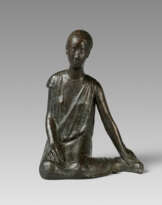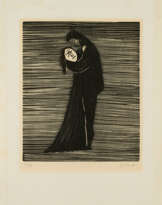ID 952166
Lot 44 | Gerhard Marcks (1889 Berlin - 1981 Burgbrohl) (F)
Estimate value
€ 15 000 – 42 000
'Falke', 1956, Bronze, dunkelbraun patiniert, Höhe 19,5 cm, im Guss monogrammiert, Gießerstempel 'Guss. Barth Bln.', 2/10 nummeriert, partiell leicht berieben, minimale weiße Farbspritzer, unterseitig leicht korrodiert, unter den Krallen Kleberückstände, Literatur: Wvz. Marcks Tgb. G/B 440, Rudloff 649, mit Abb. S. 386. Ausstellungen: (wohl je anderes Exemplar) New York 1961 (Otto Gerson Gallery), Gerhard Marcks: Paintings, Watercolors, Sculpture, Kat.-Nr. 4. New York 1967 (Leonard Hutton Galleries), A Comprehensive Exhibition of Bronze Sculpture by Gerhard Marcks, Kat.-Nr. 53. Köln 1969 (Kunstverein), Gerhard Marcks: Werke der Kölner Jahre 1950 bis 1969, Kat.-Nr. 30. Köln 1974 (Galerie Lempertz), Gerhard Marcks, Kat.-Nr. 31. Hannover 1974 (Galerie Koch), Gerhard Marcks, Kat.-Nr. 33. Düsseldorf 1974 (Galerie Vömel), Gerhard Marcks, Kat.-Nr. 18. Mainz 1975 (Galerie Brumme), Bildhauer aus drei Generationen, Kat.-Nr. 60
Gerhard Marcks wurde 1889 in Berlin geboren und ist einer der bedeutendsten deutschen Bildhauer und Grafiker. In seinen ersten Schaffensjahren arbeitete er zunächst mit Richard Scheibe, August Gaul und Georg Kolbe. In den Jahren 1919-1925 leitete er die Töpferwerkstätte am Bauhaus in Weimar, wo auch seine ersten expressionistisch beeinflussten Holzschnittfolgen entstanden. Noch bevor er von den Nationalsozialisten entlassen wurde und seine Kunst als "entartet" diffamiert wurde, lehrte er die Bildhauerklasse an der Kunstgewerbeschule in Halle/Saale. Später, 1946-50 unterrichtete er weiter an der Hamburger Landeskunstschule und an den Werkkunstschulen in Köln. 1951 wurde er zum Juror der Kunstausstellung Eisen und Stahl berufen, seit 1955 war er Mitglied der Berliner Akademie der Künste. 1971 wurde das Gerhard-Marcks-Haus in Bremen eröffnet, das seinen künstlerischen Nachlass verwaltet. 1980, ein Jahr vor dem Ableben des Künstlers, wurde er als auswärtiges Ehrenmitglied in die American Academy of Arts and Letters gewählt. Schon dieser Umriss in wenigen Zeilen zeigt bereits das umfangreiche Schaffen Gerhard Marcks - sowohl als Künstler als auch als Lehrender. Sicherlich hat er auch seine Auffassung und Techniken Figuren zu erstellen an seine Schüler weitergegeben und diese selbst durch die Symbiose von Lehrer und Lehrling immer weiter vorantreiben können. Dr. Arie Hartog, Direktor des Gerhard Marcks Hauses, erklärt dazu: "Wenn man Marcks als Bildhauer verstehen will, so sind die Zeichnungen sehr wichtig. Er hat immer nach dem Modell gezeichnet und dann hat er die Zeichnungen in sein Atelier genommen und, man könnte sagen, das Modell weggeschickt. Denn, er wollte sich nicht ablenken lassen von dem Modell, sondern die Formfindung, die in der Zeichnung stattgefunden hat, dann in Bildhauerei umsetzen." Dabei ist zu beobachten, dass sich die Mensch- und Tierfiguren des Künstlers vom Einfluss der antiken griechischen Skulptur und vom anfänglichen Expressionismus, ablösen und von ihm künstlerisch zu abstrahierter und knapperer Form gelenkt wurden. Wesentlich scheint dabei auch der Aufbau der Figuren, die oftmals sowohl das naturnahe Modell als auch die stereometrischen Formbezüge in harmonischem Gleichgewicht in sich tragen. Eben jener Naturbezug, die Auffassung in der Natur gutes und schönes finden zu können und eben diese Aspekte auf unzählige Weise auf skulpturale Weise herauszuarbeiten ist der Anspruch des Künstlers, den er in der Ausführung der Bronzen einhält. Dabei weist der Künstler eine vorzügliche Linienführung auf, denkt die Linien geradezu bildhauerisch und wandelt die naturnahen Geschöpfe, die beiden Vögel, gekonnt in Figuren um. Der jagende Falke mit abzielendem Blick, spitzem Schnabel und ebenso spitz zulaufenden Flügeln, beweist, ebenso wie die Stadttaube mit ihren leicht kurvigen Formen, das hohe Formverständnis des Künstlers. Wir freuen uns daher ganz besonders den Falken, der bisher nur ein Mal auf dem Auktionsmarkt zu finden war, anbieten zu dürfen! Die Bildgießerei Richard Barth wurde bereits 1929 gegründet ist für Güsse namhafter Bildhauer bekannt. Der Falke von Marcks wurde im traditionellen Verfahren lediglich zehnfach hergestellt.
Gerhard Marcks (1889 Berlin - 1981 Burgbrohl) (F)
'Falke', 1956, bronze, dark brown patina, height 19,5 cm, monogrammed in the casting, foundry stamp 'Guss. Barth Bln.', numbered 2/10, partially slightly rubbed, minimal white paint splashes, slightly corroded on the underside, glue residues under the claws, literature: Wvz. Marcks Tgb. G/B 440, Rudloff 649, with ill. p. 386
Gerhard Marcks was born in Berlin in 1889 and is considered one of the most important German sculptors and graphic artists. In his early creative years, he initially worked with Richard Scheibe, August Gaul and Georg Kolbe. Until 1919-1925, when he headed the pottery workshop at the Bauhaus in Weimar, where he also created his first expressionist-influenced woodcut series. Even before he was dismissed by the National Socialists and his art was defamed as "degenerate", he taught the sculpture class at the Kunstgewerbeschule in Halle/ Saale. Later, 1946-50, he continued to teach at the Hamburg Landeskunstschule and at the Werkkunstschulen in Cologne. In 1951 he was appointed juror of the art exhibition Eisen und Stahl, and from 1955 he was a member of the Berlin Academy of Arts. In 1971, the Gerhard Marcks House was opened in Bremen, which administers his artistic estate. In 1980, a year before the artist's passing, he was elected an honorary foreign member of the American Academy of Arts and Letters.
This outline in just a few lines already shows Gerhard Marck's extensive oeuvre - both as an artist and as a teacher. Certainly he also passed on his conception and techniques of creating figures to his students and was able to advance them himself through the symbiosis of teacher and apprentice.
Dr. Arie Hartog, director of the Gerhard Marcks House, explains: "If you want to understand Marcks as a sculptor, the drawings are very important. He always drew from the model and then he took the drawings into his studio and, you could say, sent the model away. Because, he didn't want to be distracted by the model, but to then translate the form-finding that took place in the drawing into sculpture." It can be observed that the artist's human and animal figures were detached from the influence of ancient Greek sculpture and from the initial Expressionism, and were artistically directed by him towards more abstract and concise form. The structure of the figures, which often carry both, the naturalistic model and the stereometric forma, references in a harmonious balance, seems to be essential. It is precisely this reference to nature, the view of being able to find good and beautiful things in nature and to work out precisely these aspects in countless ways in sculptural form that is the artist's claim, which he adheres to in the execution of the bronzes.
The artist shows an exquisite line management, thinks the lines almost like sculpture and skilfully transforms the natural creatures, the two birds, into figures. The hunting falcon with its aiming gaze, pointed beak and equally pointed wings, as well as the city pigeon with its slightly curved forms, demonstrate the artist's high understanding of form. We are therefore particularly pleased to be able to offer the falcon, which has only been on the auction market once before! The Richard Barth foundry was founded in Berlin in 1929 and is now based in Rinteln.
| Artist: | Gerhard Marcks (1889 - 1981) |
|---|---|
| Auction house category: | Sculpture |
| Artist: | Gerhard Marcks (1889 - 1981) |
|---|---|
| Auction house category: | Sculpture |
| Address of auction |
WETTMANN Luxusuhren Bredeneyer Straße 119-121 45133 Essen Germany | ||||||||||||||
|---|---|---|---|---|---|---|---|---|---|---|---|---|---|---|---|
| Preview |
| ||||||||||||||
| Phone | +4920185785190 | ||||||||||||||
| Fax | +49 (0)208 439 17 35 | ||||||||||||||
| Buyer Premium | 14,28% | ||||||||||||||
| Conditions of purchase | Conditions of purchase | ||||||||||||||
| Shipping |
Postal service Courier service pickup by yourself | ||||||||||||||
| Payment methods |
Wire Transfer | ||||||||||||||
| Business hours | Business hours
|
















